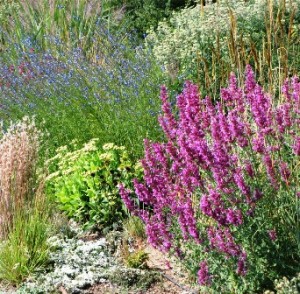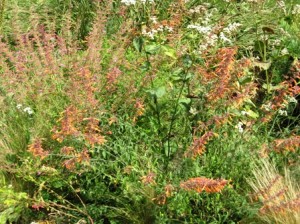Agastache was an easy pick for this month of September because as I strolled through my garden, I noticed three varieties in bloom and going strong. And with the glut of new cultivars in the marketplace over the past several years, I feel somewhat like a child in a candy shop trying to limit myself to only one type of candy when all of them look so scrumptious.
This genus consists of about 30 aromatic perennials and is a real sun lover. It also needs well drained soil in order to thrive. Several of these plants are found in the hilly areas of the U.S., Mexico, China and Japan.
I have not always had success in growing agastache. My first attempt was with Agastache ‘Black Adder’. It has very deep charcoal blue purple flowers with dark stems. It was a stand out in the middle of one of my perennial borders and looked terrific partnered with Alchillea ‘Anthea’. But come the next spring, not one of the seven plants was to be found anywhere. Perhaps they didn’t survive a cold Zone 6 winter, although they are supposed to be hardy down through Zone 6.
 Since then, I’ve had greater success with other varieties. One of my favorites is Agastache rupestris, commonly known as Licorice Mint or Sunset Hyssop. It has shrimp pink flowers and blooms for me from late June straight through October. I love its silvery green, thin leaves with it shimmery, tubular, spicy flowers that attract hummingbirds. With a height of 36″ up, I’ve successfully paired it in my garden this year with Artemesia ‘Powis Castle’ and Panicum virgatum ‘Dallas Blue’. So far, so good.
Since then, I’ve had greater success with other varieties. One of my favorites is Agastache rupestris, commonly known as Licorice Mint or Sunset Hyssop. It has shrimp pink flowers and blooms for me from late June straight through October. I love its silvery green, thin leaves with it shimmery, tubular, spicy flowers that attract hummingbirds. With a height of 36″ up, I’ve successfully paired it in my garden this year with Artemesia ‘Powis Castle’ and Panicum virgatum ‘Dallas Blue’. So far, so good.
Another variety that I’m using in the front of the border nestled up to an antique hued, purplish blue hydrangea is ‘Golden Jubilee. It is similar to ‘Blue Fortune’ but has golden yellow foliage which I find striking. The golden yellow foliage is mint scented and can even be used in teas.
David Salman, the owner and chief horticulturist of High Country Gardens has one of the best selection of agastache in the country. This year he is advertising 18 varieties, 13 of which are xeric. The one that I find most irresistible is ‘Ava’. It has been released by High Country Gardens and David considers it to be one of the finest. It is a hybrid between Agastache ‘cana’ and ‘barberi’ with huge spikes of deep rose pink flowers, raspberry red calyxes and scented foliage whose color maintains it deep color straight through the frost. For more information on the great selections of agastache at High Country Gardens, click here.
 Now it’s your turn to let us know which agastaches you grow in your garden. Any suggestions, ideas, successes and failure? As always, we’ll offer links to your post for those who send us photos.
Now it’s your turn to let us know which agastaches you grow in your garden. Any suggestions, ideas, successes and failure? As always, we’ll offer links to your post for those who send us photos.


